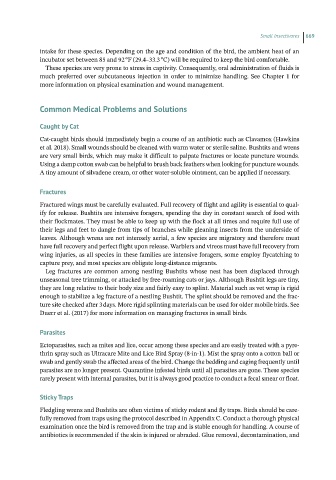Page 668 - Hand rearing birds second
P. 668
Small Insectivores 669
intake for these species. Depending on the age and condition of the bird, the ambient heat of an
incubator set between 85 and 92 °F (29.4–33.3 °C) will be required to keep the bird comfortable.
These species are very prone to stress in captivity. Consequently, oral administration of fluids is
much preferred over subcutaneous injection in order to minimize handling. See Chapter 1 for
more information on physical examination and wound management.
CommonMedicalProblemsand Solutions
Caught by Cat
Cat‐caught birds should immediately begin a course of an antibiotic such as Clavamox (Hawkins
et al. 2018). Small wounds should be cleaned with warm water or sterile saline. Bushtits and wrens
are very small birds, which may make it difficult to palpate fractures or locate puncture wounds.
Using a damp cotton swab can be helpful to brush back feathers when looking for puncture wounds.
A tiny amount of silvadene cream, or other water‐soluble ointment, can be applied if necessary.
Fractures
Fractured wings must be carefully evaluated. Full recovery of flight and agility is essential to qual-
ify for release. Bushtits are intensive foragers, spending the day in constant search of food with
their flockmates. They must be able to keep up with the flock at all times and require full use of
their legs and feet to dangle from tips of branches while gleaning insects from the underside of
leaves. Although wrens are not intensely aerial, a few species are migratory and therefore must
have full recovery and perfect flight upon release. Warblers and vireos must have full recovery from
wing injuries, as all species in these families are intensive foragers, some employ flycatching to
capture prey, and most species are obligate long‐distance migrants.
Leg fractures are common among nestling Bushtits whose nest has been displaced through
unseasonal tree trimming, or attacked by free‐roaming cats or jays. Although Bushtit legs are tiny,
they are long relative to their body size and fairly easy to splint. Material such as vet wrap is rigid
enough to stabilize a leg fracture of a nestling Bushtit. The splint should be removed and the frac-
ture site checked after 3 days. More rigid splinting materials can be used for older mobile birds. See
Duerr et al. (2017) for more information on managing fractures in small birds.
Parasites
Ectoparasites, such as mites and lice, occur among these species and are easily treated with a pyre-
thrin spray such as Ultracare Mite and Lice Bird Spray (8‐in‐1). Mist the spray onto a cotton ball or
swab and gently swab the affected areas of the bird. Change the bedding and caging frequently until
parasites are no longer present. Quarantine infested birds until all parasites are gone. These species
rarely present with internal parasites, but it is always good practice to conduct a fecal smear or float.
Sticky Traps
Fledgling wrens and Bushtits are often victims of sticky rodent and fly traps. Birds should be care-
fully removed from traps using the protocol described in Appendix C. Conduct a thorough physical
examination once the bird is removed from the trap and is stable enough for handling. A course of
antibiotics is recommended if the skin is injured or abraded. Glue removal, decontamination, and

